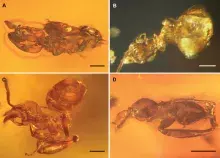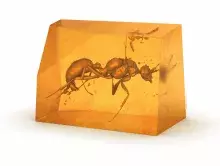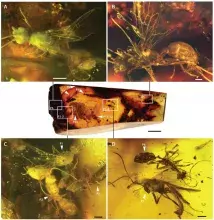New Miocene amber ants from Ethiopia in the collection of the Museum of Amber Inclusions UG
An international team of scientists, which also includes researchers from the University of Gdańsk - Professor Jacek Szwedo and Błażej Bojarski from the Laboratory of Evolutionary Entomology and Museum of Amber Inclusions, has recently described more species of ants from Miocene Ethiopian amber, the largest collection of which is housed in the Museum of Amber Inclusions at the University of Gdańsk. Thanks to this research, our collection has been enriched with more type specimens representing extinct ants. The studied inclusions are two paratypes of the new species Technomyrmex svojtkai Perrichot et Engel, 2022 (family Formicidae, subfamily Dolichoderinae, tribe Tapinomini), and the holotype and 12 paratypes of a new species, also classified in a new genus – Desyopone hereon Boudinot et Perrichot, 2022 (Formicidae, subfamily Ponerinae).
The fossil resin from the early Miocene of Ethiopia provides a new source of information on extinct ants from Africa, where their fossils are poorly documented. Inclusions of six subfamilies and at least 19 genera that are still found in the Afrotropical region today were identified in the study material. Synchrotron radiation and computed microtomography, among others, were used to study these inclusions. The taxonomic composition of ants in Ethiopian amber is consistent with the global pattern of distribution and evolution appearing in these insects. At the same time, it indicates Neogene diversification almost exclusively within existing genera. The new extinct genus Desyopone gen. nov. is the first case of an extinct form that is endemic to Ethiopian amber to date. The findings presented, also changed the approach to interpreting fossil and modern materials - helping to put male ants in the spotlight of evolutionary research.
The fossil resin from Ethiopia is a unique material for palaeontological and palaeobiological research, and it is as unique as the inclusions it contains. Few fossil insect sites are known from Africa, and they remain insufficiently studied. Although amber has long been used as a jewelry-making material by the people of the Amhara region of Ethiopia, its scientific significance has only become clear to researchers in the last 10 years. The challenge is still to more accurately determine the age of this fossil resin, by determining the age of the fossil palinomorphs – spores and pollen – enclosed in the amber, indirectly its age can be determined at 16 to 23 million years. The Ethiopian amber and the inclusions it contains provide a unique insight into the ecosystem of an ancient early Miocene forest in Africa, during a period of climatic and environmental change.
Publications co-authored by researchers from the University of Gdańsk on Miocene ants from Ethiopia have appeared in the Zoological Journal of the Linnean Society and in Insects.
Perrichot V., Boudinot B.E., Engel M.S., Xu, C.P., Bojarski B., Szwedo J. 2022. Ants (Hymenoptera: Formicidae) from Miocene Ethiopian amber: filling gaps in the geological record of African terrestrial biota. Zoological Journal of the Linnean Society; published online 20 July 2022. https://doi.org/10.1093/zoolinnean/zlabc053/6646822
Boudinot B.E, Richter A.K., Hammel J.U., Szwedo J., Bojarski B., Perrichot V. 2022. Genomic-phenomic reciprocal illumination: †Desyopone gen. nov., an exceptional aneuretine-like fossil ant from Ethiopian amber (Hymenoptera: Formicidae: Ponerinae). Insects, 13 (9), 796, 1–19. https://doi.org/10.3390/insects13090796
Technomyrmex svojtkai, photomicrographs of paratype workers and additional, partial worker, specimen MAIG 6020. A, paratype 1, ventral view. B, paratype 2, dorsal view. C, paratype 2, left lateral view, anterior-oblique orientation. D, non-type, partially preserved worker, right lateral view. Scale bars: 0.25 mm.
Photograph of entire amber piece MAIG 6016, with indication of type specimens (labeled H for holotype, P1–P12 for paratypes) of Desyopone hereon, and with detailed views of seven of them (A–D). (A) paratype 4; (B) holotype; (C) paratypes 1–3; (D) paratypes 5–6. Scale bars: 0.5 mm.
Three-dimensional image of Desyopone hereon. Picture: Jörg Hammel/Jonas Lauströer, Deutsches Elektronen-Synchrotron DESY, Helmholtz-Zentrum Hereon, X-ray light source PETRA III.







